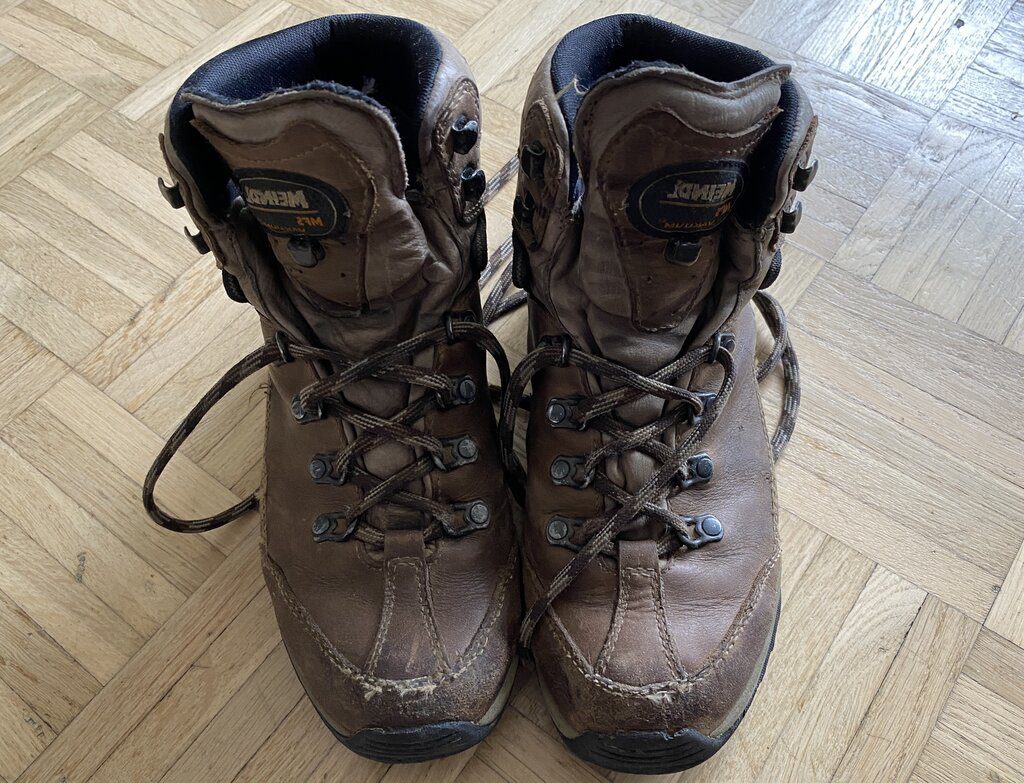Bought top-notch leather hiking boots? Take care of them right to make them last!
I’ve noticed that my leather boots tend to be more susceptible to cracks and scrapes than the ones I own made of synthetic materials. They also can dry out if not regularly conditioned.
As such, read until the end as we’ll walk you through a step-by-step process to care for these boots, ensuring they remain in top shape for your many journeys ahead.
Additionally, we’ll sprinkle in some expert tips to enhance your boot care routine.
How To Maintain Your Leather Hiking Boots
Now that you know it only takes a few minutes to take proper care of your hiking boots, you should feel confident in completing the following steps after every hiking adventure.
Here’s the step-by-step process that I follow to prolong the life of my leather boots.
- I first clean my boots
- I apply conditioner or waterproofing treatment
- I gently buff them
- Dry my boots and store them correctly.
1. Carefully Clean Your Leather Boots

My hiking boots cleaning process begins before I leave the trail area.
I remove my boots and take a few minutes to bang their soles together to loosen any mud or dirt before it has a chance to settle into the leather.
At home, I start the complete cleaning process by removing the laces and the insoles (if they are removable).
After that, I take a few minutes to rinse the boots until I’ve removed all of the dirt and grit.
Using a boot brush during this step helps, making any dried mud come off much easier. If you don’t have a proper shoebrush, you can also use an old toothbrush, which also works to gently remove dust.
During cleaning, also focus on the tongue and the areas around the lace grommets, as these spots often accumulate dirt.
I always avoid using regular bar soap or dish soap on the leather upper. Although these products may work for other materials, they aren’t the best for leather. However, you can use them when scrubbing the boots’ outsoles.
2. Apply A Leather Conditioner or Re-Waterproof Them

Once you’ve cleaned your boots, you want to use a specialized product to condition or waterproof them. Make sure you check your manufacturer’s instructions. These products differ based on the leather type: full-grain leather or “rough leather” like nubuck or suede.
For full-grain leather boots, you should use a conditioner. This product not only conditions the leather but also renews the boot’s water-repellant properties, which restores the waterproofing. A good product we tried is Venetian Imperial Leather Balm.
For hiking boots with a Gore-Tex® membrane, there’s no need for special treatment
For suede, nubuck, or other types of leather, you will need to perform a re-waterproofing treatment using a specialized product. We recommend Nikwax Nubuck & Suede Proof.

Although many more accessible products exist on the market, some people still like to perform this step using wax.
I have used waterproofing wax before on my full-grain leather boots because it waterproofs them well and takes care of the conditioning.
However, while the wax effectively waterproofs your boots, its residue can seep into the hiking boot outsoles, potentially complicating future resoling.
Ensure that water is soaked fully into the boot leather before applying any treatment. We noticed that this helps in drawing the waterproofing treatment fully into the boots.
3. Buff Your Boots
Once you’ve cleaned and waterproofed the boots, buff them with a clean cloth.
This step polishes the boots and gets rid of leftover residue. It also dries off any surface moisture, which is helpful for the drying stage.
4. Properly Dry And Store Them

I always remind others how essential it is to dry their boots properly. Taking shortcuts can harm the boots.
You should let the boots air dry naturally, even if it takes longer for them to dry completely (hanging them if possible).
If you are in a rush, stuff newspaper inside the boots to speed up the process, but avoid drying boots with heat sources like radiators or hair dryers.
Intense heat can cause leather shoes to shrink or warp.
Once fully dry, put the insoles and laces back, and store in a cool, dry place.
Avoid keeping boots in places like cellars, garages, or any areas that are damp, hot, or lack proper ventilation.
FAQs
Apply a leather conditioner to your leather footwear every time you perform a full cleaning. Dirt dries out leather and causes cracks. A conditioner replenishes the natural oils in the leather, preventing it from becoming brittle and dry.
For a homemade leather conditioner, melt 1 part beeswax with 2 parts cocoa butter in a double boiler, then blend in 2 parts sweet almond oil. Once cooled, apply sparingly to clean leather using a soft cloth in circular motions.
When caring for suede leather hiking boots, special considerations apply. Use a dedicated suede leather cleaner to gently remove dirt and stains. Avoid excessive water and scrubbing, as they may damage the delicate suede material.








